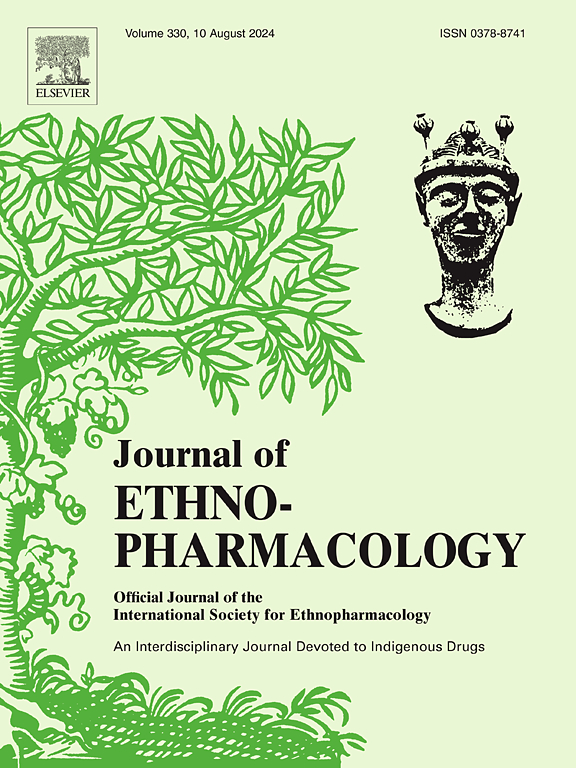Shexiang Tongxin Dropping Pills attenuate ischemic microvascular dysfunction via suppressing P66Shc-mediated mitochondrial respiration deficits
IF 4.8
2区 医学
Q1 CHEMISTRY, MEDICINAL
引用次数: 0
Abstract
Ethnopharmacological relevance
Ischemic stroke (IS) disrupts mitochondrial energy metabolism, leading to cerebral microvascular dysfunction (CMD). Shexiang Tongxin Dropping Pills (STDP) is a traditional Chinese medicinal formulation that has been clinically used for treating microcirculatory dysfunction. We have previously reported its ability to improve cerebral microcirculatory abnormalities. Nevertheless, the protective effects of STDP on cerebral microvascular mitochondria in the context of energy metabolism repair remain underinvestigated.
Aim of the study
This study aims to investigate the potential mechanisms by which STDP ameliorates IS-induced CMD through the restoration of mitochondrial function.
Materials and methods
An ischemic stroke/reperfusion model was established by occluding and subsequently reperfusing the middle cerebral artery (MCAO/R) in C57BL/6 J mice. Laser speckle contrast imaging, Y-maze, rotarod tests and TTC staining were employed to evaluate the anti-ischemic stroke effects of STDP. Histological examination of cell adhesion proteins (ICAM 1, VCAM 1) and tight junction proteins (VE-cadherin, occludin) was conducted to assess the effects of STDP on the cerebral microvascular endothelium. In vitro, a bEnd.3 cell model was established through oxygen-glucose deprivation followed by reoxygenation (OGD/R). The cytoprotective capability of STDP was assessed by quantifying endothelial permeability, reactive oxygen species (ROS) levels, and cell viability. Mendelian randomization (MR) analysis and bioinformatic studies were performed to elucidate the causal associations between mitochondrial biological function and IS. Mitochondrial membrane potential (MMP) was assessed using a tetramethylrhodamine ethyl ester perchlorate fluorescent probe, while ATP production was quantified using a commercially available assay kit. Mitochondrial respiration was evaluated by measuring the oxygen consumption rate (OCR). Finally, the verification of important targets in mouse brain slices and bEnd.3 cells was conducted through immunoblotting and immunofluorescence.
Results
STDP significantly restored cerebral blood flow and neurological function, and reduced infarct volume in MCAO/R mice. Furthermore, STDP markedly alleviated inflammation and hyperpermeability of the cerebral microvascular endothelium in MCAO/R mice, as evidenced by the suppression of ICAM-1 and VCAM-1 expression, along with the upregulation of VE-cadherin and occludin protein levels. Moreover, STDP not only mitigated hyperpermeability and excessive production of ROS induced by OGD/R in bEnd.3 cells but also enhanced the protective effects of the ROS scavenger N-acetylcysteine on bEnd.3 cells. Results of MR analysis and bioinformation studies demonstrated that the disruption of mitochondrial respiration is a critical pathogenic factor in IS-induced CMD. Our data confirmed that STDP effectively restored MMP and ATP production in OGD/R-treated bEnd.3 cells. Furthermore, STDP significantly enhanced basal respiration, maximal OCR, and spare respiratory capacity in bEnd.3 cells compared to the OGD/R group. Mechanistically, STDP markedly increased endothelial cystathionine γ-lyase (CSE)-mediated hydrogen sulfide (H2S) production and S-sulfhydration of P66shc, resulting in reduced protein expression and phosphorylation levels of P66Shc. This inhibition prevented its translocation into mitochondria, thereby restoring mitochondrial respiration.
Conclusion
STDP facilitated CSE expression and promoted H2S production, contributing to the inactivation of P66shc by suppressing its expression and increasing its sulfhydration. This process impeded P66Shc translocation to mitochondria, subsequently restoring mitochondrial respiration and alleviating IS-induced cerebral microvascular endothelial dysfunction.

求助全文
约1分钟内获得全文
求助全文
来源期刊

Journal of ethnopharmacology
医学-全科医学与补充医学
CiteScore
10.30
自引率
5.60%
发文量
967
审稿时长
77 days
期刊介绍:
The Journal of Ethnopharmacology is dedicated to the exchange of information and understandings about people''s use of plants, fungi, animals, microorganisms and minerals and their biological and pharmacological effects based on the principles established through international conventions. Early people confronted with illness and disease, discovered a wealth of useful therapeutic agents in the plant and animal kingdoms. The empirical knowledge of these medicinal substances and their toxic potential was passed on by oral tradition and sometimes recorded in herbals and other texts on materia medica. Many valuable drugs of today (e.g., atropine, ephedrine, tubocurarine, digoxin, reserpine) came into use through the study of indigenous remedies. Chemists continue to use plant-derived drugs (e.g., morphine, taxol, physostigmine, quinidine, emetine) as prototypes in their attempts to develop more effective and less toxic medicinals.
 求助内容:
求助内容: 应助结果提醒方式:
应助结果提醒方式:


